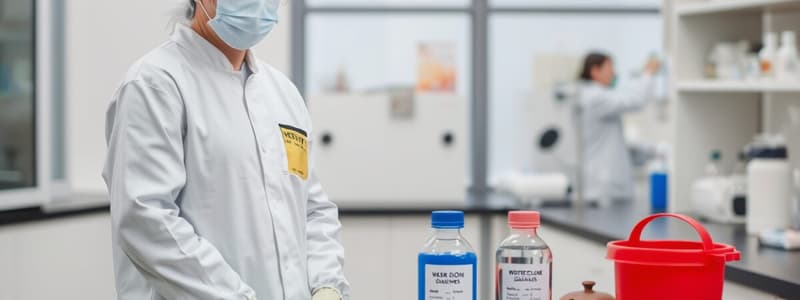Podcast
Questions and Answers
What type of gloves should be worn to protect hands from chemicals?
What type of gloves should be worn to protect hands from chemicals?
- Nitrile or latex gloves (correct)
- Leather gloves
- Cotton gloves
- Rubber gloves
Which of the following is NOT a category for waste segregation?
Which of the following is NOT a category for waste segregation?
- Recyclable
- Biohazard
- Flammable (correct)
- Hazardous
What should be used to dispose of liquid chemical waste?
What should be used to dispose of liquid chemical waste?
- Compost pile
- Regular trash bin
- Appropriate containers designated for liquid waste (correct)
- Kitchen sink
What is the purpose of using fume hoods in a laboratory?
What is the purpose of using fume hoods in a laboratory?
What safety measure should be taken before using lab equipment?
What safety measure should be taken before using lab equipment?
Why is training essential for personnel handling chemicals?
Why is training essential for personnel handling chemicals?
What should be done with needles and sharp objects in a lab?
What should be done with needles and sharp objects in a lab?
What should you do if you notice a damaged electrical cord on lab equipment?
What should you do if you notice a damaged electrical cord on lab equipment?
Flashcards are hidden until you start studying
Study Notes
Personal Protective Equipment (PPE)
- Gloves: Wear appropriate gloves (nitrile, latex) to protect hands from chemicals.
- Goggles: Use safety goggles to protect eyes from splashes or hazardous materials.
- Lab Coats: Wear long-sleeved lab coats to protect skin and personal clothing.
- Face Shields: Use face shields for additional facial protection when necessary.
- Footwear: Closed-toe shoes are required; avoid sandals or open-toed footwear.
Waste Disposal Guidelines
- Segregation: Separate waste into categories: hazardous, non-hazardous, biohazard, and recyclable.
- Containers: Use designated containers for each type of waste; label them clearly.
- Liquid Waste: Dispose of liquid chemical waste in appropriate containers, never down the sink.
- Sharps: Dispose of needles and sharp objects in puncture-proof containers.
- Regular Disposal: Follow institutional protocols for the regular collection and disposal of waste.
Chemical Handling Procedures
- Labeling: Ensure all chemicals are clearly labeled with contents and hazards.
- Storage: Store chemicals according to compatibility; flammable materials away from oxidizers.
- Fume Hoods: Use fume hoods when working with volatile or hazardous chemicals.
- Spill Management: Have spill kits available and know procedures for minor spills.
- Training: Ensure all personnel are trained in chemical hazards and handling techniques.
Lab Equipment Safety
- Inspection: Regularly check equipment for damage or malfunctions before use.
- Usage: Follow manufacturer instructions and lab protocols for operating equipment.
- Maintenance: Report any issues and perform routine maintenance as scheduled.
- Electrical Safety: Ensure cords are intact and equipment is grounded; avoid overloads.
- Emergency Stops: Know the location and function of emergency shut-off switches.
Emergency Response Protocols
- Emergency Numbers: Keep emergency contact numbers visible and accessible.
- Evacuation Routes: Familiarize with evacuation routes and emergency exits.
- First Aid Kits: Ensure first aid kits are stocked and accessible; know their location.
- Fire Safety: Know the location of fire extinguishers and how to use them.
- Incident Reporting: Report all accidents, spills, or injuries to the appropriate personnel immediately.
Personal Protective Equipment (PPE)
- Gloves made from nitrile or latex protect hands from chemical exposure.
- Safety goggles shield eyes from hazardous splashes and materials.
- Long-sleeved lab coats safeguard skin and clothing from spills.
- Face shields provide extra facial protection when needed.
- Closed-toe footwear is mandatory; sandals or open-toe shoes are not allowed.
Waste Disposal Guidelines
- Waste must be separated into categories: hazardous, non-hazardous, biohazard, and recyclable.
- Clearly label designated containers for each category of waste to prevent confusion.
- Liquid chemical waste should be disposed of in proper containers, never down drains.
- Needles and sharp objects must be placed in puncture-proof containers for safe disposal.
- Adhere to institutional protocols for regular waste collection and disposal.
Chemical Handling Procedures
- Chemicals must be clearly labeled with their contents and associated hazards.
- Store chemicals based on compatibility; keep flammable items away from oxidizers.
- Utilize fume hoods when handling volatile or hazardous substances to minimize inhalation risks.
- Spill kits should be readily available, and staff must be trained on minor spill response procedures.
- Personnel should receive training on chemical hazards and safe handling practices.
Lab Equipment Safety
- Regularly inspect equipment for any damages or malfunctions prior to use.
- Adhere to manufacturer instructions and laboratory protocols when operating equipment.
- Report malfunctions immediately and conduct scheduled routine maintenance.
- Ensure that electrical cords are intact and that equipment is properly grounded to prevent overloads.
- Be aware of the location and operation of emergency shut-off switches for equipment.
Emergency Response Protocols
- Maintain visibility of emergency contact numbers for quick access during crises.
- Familiarize yourself with the evacuation routes and exits for quick escape in emergencies.
- Ensure that first aid kits are fully stocked and their locations are known to all lab personnel.
- Know where fire extinguishers are located and learn how to operate them effectively.
- Promptly report all accidents, spills, or injuries to designated personnel for proper handling.
Studying That Suits You
Use AI to generate personalized quizzes and flashcards to suit your learning preferences.




